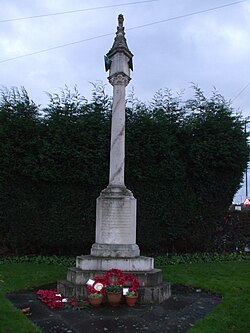Hockley Heath
| Hockley Heath | |
| Warwickshire | |
|---|---|
 The War memorial, Hockley Heath | |
| Location | |
| Location: | 52°21’21"N, 1°46’39"W |
| Data | |
| Population: | 2,038 (2011) |
| Post town: | Solihull |
| Postcode: | B94 |
| Dialling code: | 01564 |
| Local Government | |
| Council: | Solihull |
| Parliamentary constituency: |
Meriden |
| Website: | hockleyheath-pc.gov.uk |
Hockley Heath is a village and civil parish in Warwickshire to the south of the West Midlands conurbation. It lies 12 miles from Birmingham, 5½ miles from Solihull and 12½ miles from Stratford-upon-Avon.
History
Hockley Heath lies on the boundaries of the ancient parishes of Tanworth, Packwood, Lapworth and Hampton-in-Arden (Nuthurst). The earliest reference here is to Nuthurst, situated south of the present-day village. Dugdale found no mention of it before the reign of Henry III (1216–72)[1] but it has been identified with the woodland 'aet Hnuthyrste' given with Shottery to Worcester Cathedral by Offa c. 705.[2] Werfryd, Bishop of Worcester, in 872 granted to Eanwulf, the King's thane, land at Hnuthyrst for four lives, with reversion to the monastery of Stratford. After the Norman Conquest the name usually appeared as Notehurst, but gradually reverted to its present and original spelling. Hockley Heath first appeared in the 13th century.[3] It was part of Hampton-in-Arden, and 1/5 knight's fee in Nuthurst was held of Niel de Mowbray c. 1230 and of Roger de Mowbray in 1242. The overlordship descended in this family, being held by Roger de Mowbray at his death in 1297, and by John Mowbray, Duke of Norfolk, in 1432.[2] After the Mowbrays it passed to the Montforts, Hastings and then to the Trussells and it was Sir William Trussell of Nuthurst who informed Edward II of his disposition in favour of his son.[1] By the 18th century it had passed to the Archers of Umberslade Hall and Lord Archer raised an obelisk on the estate. The reason for the obelisk is uncertain.
The village was attacked during the First World War when Zeppelin L 62 bombed the village during an attempted raid on Birmingham but heavy anti-aircraft fire prevented the airship from getting near the city centre.[4]
Notable landmarks
The ecclesiastical parish of Nuthurst cum Hockley Heath was formed in 1878 with the addition of the modern village of Hockley Heath from Tanworth. It lies for the most part between two roads from Henley-in-Arden to Birmingham which meet in the extreme north of the civil parish, where the church of St Thomas, designed by John Cotton, a red-brick structure in the Early English style, was built in 1879[5] and consecrated on 30 June 1880, having cost £2,500. It was dedicated to St Thomas, as a compliment to Thomas Burman, of Warings Green, who, as the chief subscriber, laid the foundation stone in 1879.[3]
Situated at the junction of the A3400 Stratford on Avon to Birmingham Road and the B4439, known as the Old Warwick Road is the War Memorial to those killed during the two World Wars.
Transport links
The village is situated on the main A3400 Birmingham to Stratford Road, 2½ miles south of junction 4 of the M42 motorway, whilst two miles south of the village there is a junction off the southbound carriageway of the M40 motorway.
Dorridge railway station is the nearest station to the village at two miles distance, with local connections to Solihull, Birmingham and Warwick and main line connections to London Marylebone.
The Stratford-upon-Avon Canal runs through the village and Hockley Heath Wharf, situated to the rear of The Wharf Public house, meant it became one the Arden villages which later became a convenient stopping off point for users of the canal.
References
| ("Wikimedia Commons" has material about Hockley Heath) |
- ↑ 1.0 1.1 The Antiquities of Warwickshire, William Dugdale, 1656
- ↑ 2.0 2.1 A History of the County of Warwick: Volume 3
- ↑ 3.0 3.1 In the Forest of Arden, John Burman, 1948
- ↑ "Sitesafe UXO Desk Study". Birmingham City Council. http://eplanning.birmingham.gov.uk/Northgate/DocumentExplorer/documentstream/documentstream.aspx?name=public:0901487a80b6c174.pdf&unique=433148&type=eplprod_DC_PLANAPP. Retrieved 21 April 2012.
- ↑ Nikolaus Pevsner and Alexandra Wedgwood, The Buildings of England, Warwickshire, 1966, ISBN 0-14-071031-0

